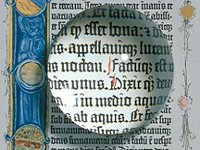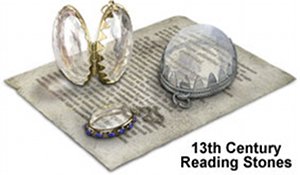Optics began with the development of lenses by the ancient Egyptians and Mesopotamians. The earliest known lenses were made from polished crystal, often quartz, and have been dated as early as 700 B.C.
The ancient Romans and Greeks filled glass spheres with water to make lenses. These practical developments were followed by the development of theories of light and vision by ancient Greek and Indian philosophers, and the development of geometrical optics in the Greco-Roman world.
The word optics comes from the ancient Greek word optikos of or having to do with sight
.
Plato first articulated his emission theory, the idea that visual perception is accomplished by rays of light
emitted by the eyes and commented on the parity reversal of mirrors in Timaeus.
Some hundred years later, Euclid wrote a treatise entitled Optics, wherein he describes the mathematical rules of perspective and describes the effects of refraction qualitatively. Ptolemy, in his treatise Optics, summarizes much of Euclid and goes on to describe a way to measure the angle of refraction, though he failed to notice the empirical relationship between it and the angle of incidence.

Al-Kindi (c. 801 - 873) was one of the earliest important writers on optics in the Islamic world. In a work known in the West as De radiis stellarum, al-Kindi resurrected Plato's emission theory which had an influence on later Western scholars such as Robert Grosseteste and Roger Bacon.
In 984, the Persian mathematician, Ibn Sahl wrote a treatise On Burning Mirrors and Lenses, correctly describing a law of refraction mathematically equivalent to Snell's law. He used his law of refraction to compute the shapes of lenses and mirrors that focus light at a single point on the axis.

Ibn al-Haytham (c. 965 - 1040) is regarded as the father of modern optics
for his influential Book of Optics
,
which correctly explained and provided the first correct explanation of vision.
Ibn al-Haytham is also recognized for his experiments on lenses, mirrors, refraction, reflection, and the dispersion of light into its constituent colors. He studied binocular vision and described the finite speed of light, and argued that it is made of particles traveling in straight lines.
His Book of Optics has been ranked with Isaac Newton's Philosophiae Naturalis Principia Mathematica as one of the most influential books in the history of physics, for starting a revolution in optics and visual perception.
In the 13th century, Roger Bacon, inspired by Ibn al-Haytham, used parts of glass spheres as magnifying glasses, and discovered that light reflects from objects rather than being released from them. In Italy, around 1284, Salvino D'Armate invented the first wearable eyeglasses. The first rudimentary telescopes were developed independently in the 1570s and 1580s by Leonard Digges, Taqi al-Din and Giambattista della Porta.

The earliest known working telescopes were refracting telescopes, a type which relies entirely on lenses for magnification. Their development in the Netherlands in 1608 was by three individuals: Hans Lippershey and Zacharias Janssen, who were spectacle makers in Middelburg, Holland, and Jacob Metius of Alkmaar. In Italy, Galileo greatly improved upon these designs the following year. In 1668, Isaac Newton constructed the first practical reflecting telescope, which bears his name, the Newtonian reflector.
The first microscope was made around 1595, also in Middelburg. Three different eyeglass makers have been given credit for the invention:
Lippershey (who also developed the first real telescope); Janssen; and his father, Hans. The coining of the name microscope
has been credited to Giovanni Faber, who gave that name to Galileo's compound microscope in 1625.
